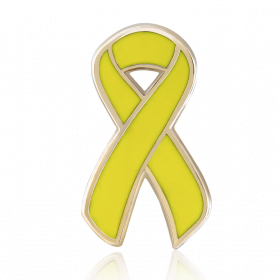From the flutter of a ribbon in the breeze to the subtle glint of an enamel pin on a coat, symbols have long been used to convey powerful messages. One such enduring symbol is the yellow ribbon—a simple strip of color that carries a history rich with meaning. Yellow ribbon pins, small but mighty in their significance, are worn across the world as markers of hope, unity, and resilience. They remind us of the strength in waiting, the power of forgiveness, and the enduring human spirit that clings to optimism even in the face of adversity. Whether tied around a tree or pinned to a lapel, the yellow ribbon is a visual shorthand for countless causes, emotions, and stories.
But what makes the yellow ribbon so special? What is the history behind this powerful symbol, and why do people wear yellow ribbon pins to this day? Let’s dive deeper into the world of yellow ribbons, uncovering the many layers of meaning behind this iconic emblem.
The History of the Yellow Ribbon
The origins of the yellow ribbon can be traced back to old traditions, folklore, and songs, each contributing to its rich symbolism. In the U.S., the yellow ribbon first gained widespread recognition during the 19th century. During wartime, particularly during the American Civil War, women would wear yellow ribbons or handkerchiefs to symbolize their hope and loyalty to soldiers fighting on the battlefield. It was a quiet but powerful way of saying, “We are waiting for you, and we hope you come back safely.”
Fast forward to the 20th century, and the yellow ribbon once again rose to prominence. This time, it was thanks to a song that captured the hearts of the nation: “Tie a Yellow Ribbon Round the Ole Oak Tree,” made famous in the 1970s by Tony Orlando and Dawn. The song tells the poignant story of a man who, after being released from prison, writes to his lover, asking her to tie a yellow ribbon around the old oak tree in front of her home if she still wants him back in her life. As he returns home by bus, anxiously awaiting her response, he sees not one but hundreds of yellow ribbons fluttering in the wind, signifying that he is not only forgiven but deeply wanted. The song became a cultural touchstone, turning the yellow ribbon into a universal symbol of longing, forgiveness, and reunion.
Since then, the yellow ribbon has been adopted for various causes, most notably as a symbol of support for troops during times of war. During the Gulf War in the early 1990s, yellow ribbons could be seen tied to trees, car antennas, and displayed in homes across the U.S., symbolizing solidarity with soldiers deployed overseas and the hope for their safe return.
The Symbolism Behind the Yellow Ribbon
The beauty of the yellow ribbon lies in its versatility. While its original meaning was deeply rooted in the context of war and soldiers returning home, its significance has evolved. Today, yellow ribbon pins represent a multitude of causes, each imbued with its unique meaning.
1. A Symbol of Hope and Safe Return
The most enduring and recognized meaning of the yellow ribbon is that of hope for the safe return of loved ones. Whether they are soldiers on the front lines or civilians separated from their families, the yellow ribbon is a visible expression of longing and anticipation. For families with relatives in the military, yellow ribbons offer a way to display their support and solidarity, even if they cannot be with their loved ones physically. In this context, yellow ribbon pins serve as a constant reminder of the importance of homecoming, safety, and family unity.
The act of wearing a yellow ribbon pin or tying a ribbon around a tree or post becomes a communal gesture—one that transcends borders and speaks to the universal experience of waiting for someone we love to return safely. It’s a beacon of optimism in a world that can often feel uncertain and chaotic.
2. A Symbol of Forgiveness and Redemption
Thanks to the legacy of the song “Tie a Yellow Ribbon,” the yellow ribbon has also come to represent forgiveness, second chances, and redemption. In the song, the man’s return from prison is met with overwhelming acceptance and love, symbolized by the yellow ribbons tied around the tree. This notion of forgiveness has carried over into the broader symbolism of the yellow ribbon, often being used to signify support for individuals who are seeking to reintegrate into society after serving time in prison.
Wearing a yellow ribbon pin can be a powerful statement of belief in the power of redemption, the idea that everyone deserves a second chance and that the past does not define the future. For many, the yellow ribbon serves as a reminder that forgiveness is not only possible but essential for healing and growth.
3. A Symbol of Awareness and Solidarity
Over time, the yellow ribbon has been adopted by various social causes and movements as a symbol of awareness and solidarity. It is now commonly used to represent causes such as suicide prevention, cancer awareness, and support for missing persons. Yellow ribbon pins are often worn at charity events, fundraisers, and memorials to raise awareness for these important issues and to show solidarity with those affected.
The flexibility of the yellow ribbon’s meaning allows it to be easily adapted to different causes while retaining its core message of hope and resilience. It serves as a unifying symbol for individuals and communities working to raise awareness, offer support, and inspire action.
Yellow Ribbon Pins: More Than Just Accessories
Yellow ribbon pins are more than just decorative accessories—they are wearable symbols that carry deep emotional significance. Whether worn on a jacket, shirt, or bag, these pins serve as constant reminders of the causes and values they represent. The simple act of pinning a yellow ribbon to one’s clothing can spark conversations, raise awareness, and foster a sense of connection with others who share the same cause or experience.
The design of yellow ribbon pins varies widely, from minimalist enamel pins with the traditional ribbon cut-out to more elaborate versions with added details and embellishments. Many organizations produce yellow ribbon pins specifically for fundraising purposes, with proceeds going towards supporting veterans, cancer research, or other charitable causes. In this way, the act of wearing a yellow ribbon pin becomes not only a personal statement but also a contribution to a larger cause.
The Cultural Impact of Yellow Ribbons
Over the years, yellow ribbons have taken on a life of their own, becoming deeply ingrained in popular culture and public consciousness. They have appeared in films, television shows, literature, and music, each time reinforcing the powerful emotions and stories they represent. In times of national crisis or war, yellow ribbons often re-emerge as symbols of unity and collective hope, rallying people together in support of a common cause.
One of the most striking examples of this is the use of yellow ribbons during times of war. From the Vietnam War to the Gulf War and beyond, yellow ribbons have been tied to trees, posts, and fences as visible signs of support for soldiers and their families. The simple act of tying a ribbon has become a way for people to express their emotions, even if they feel powerless to change the outcome of the situation.
Why Yellow?
So, why yellow? The color yellow has long been associated with optimism, happiness, and warmth. It is a color that stands out, catching the eye and drawing attention. In the context of the yellow ribbon, the color serves as a symbol of hope, signaling that better days are ahead. It is also a color of safety, often used in caution signs and warning signals, which ties into the yellow ribbon’s association with protection and safe return.
In many cultures, yellow is also linked to the idea of renewal and new beginnings, making it a fitting choice for a symbol that represents second chances, reconciliation, and the hope for a fresh start. Whether worn as a pin or tied around a tree, the yellow ribbon’s bright and cheerful color contrasts with the often somber emotions it represents, serving as a reminder that hope and optimism can exist even in the darkest times.
Conclusion: The Enduring Power of the Yellow Ribbon
The yellow ribbon, in all its forms, remains a symbol of hope, resilience, and unity. Whether worn as a pin, tied around a tree, or displayed in a window, it carries with it a powerful message: we are waiting, we are hopeful, and we believe in the possibility of reunion and redemption. Over the years, the yellow ribbon has come to represent so much more than its original meaning—it is now a universal symbol of solidarity with those who are missing, those who are struggling, and those who are searching for a second chance.
In today’s world, where it can be easy to feel disconnected or divided, the yellow ribbon reminds us of the importance of coming together, supporting one another, and holding onto hope even when the future feels uncertain. Yellow ribbon pins, small but significant, allow us to carry these messages with us wherever we go, making the world just a little bit brighter with each ribbon we wear.
So, the next time you see a yellow ribbon pin, know that it is more than just a piece of jewelry. It is a statement, a symbol, and a testament to the enduring human spirit—one that refuses to give up, even when the odds are against us.





